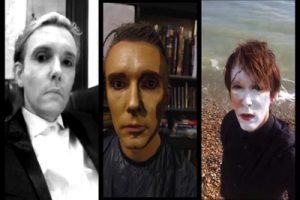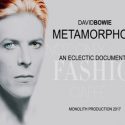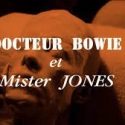David Bowie Related 2016 – Being Bowie – Documentary Will Brooker (2016)
by Will Brooker and Rebecca Hughes
Video: H264 MPEG-4 AVC 1280×720
Audio: MP4A 128 kbps
Brooker
This film documents a project that began when a musical hero and cultural icon of mine died. Lou Reed passed away in October 2013, which made me realise I should celebrate one of my other heroes, David Bowie, while he was still alive. My way of paying tribute was to propose an academic book on Bowie, which was commissioned by I B Tauris in 2014. In May 2015, I began my research. I was immediately daunted by the existing library of books on Bowie and looked for a new approach, a way of entry into this vast amount of material about a complex performer who had been working professionally for 50 years. I decided to try to reconstruct and enter into Bowie’s cultural framework; to experience some of what he experienced, to engage with his influences and see if it gave me insight into his creative output at various times. Using all the available biographies I drew up lists of the books he read, the films he watched, the music he loved, and constructed a chronology from it. I immersed myself in what Bowie had experienced at each historical moment, avoiding any more recent culture. To commit further to the project I had my hair styled and coloured like Bowie’s from the mid-1970s and wore only vintage clothes. I visited the locations where Bowie grew up, walking the same streets. As a filmmaker, photographer, and cinema scholar I decided I should also experience the other side of the camera as Bowie did, and I arranged photo shoots with professional stylists, focusing on how it felt to wear the elaborate make-up and to sit under hot lights and project the Ziggy persona.
The project grew from there as I increasingly immersed myself in Bowie’s experiences, moving chronologically from the 1960s to the 1970s: the isolation and Nazi/occult literature of the Thin White Duke period, the ‘Oblique Strategies’ cards to prompt creative decisions, the experiments with painting, the long walks around Berlin, the cab rides through California and Philadelphia, the subsequent lack of sleep, and ultimately a degree of second-hand celebrity, as the media picked up on my research and I was interviewed by international newspaper, television, and radio journalists. The expectations of the media further committed me to the research. I began to perform as a Bowie tribute act and to rehearse with an established band, The Thin White Duke. Moving into the 1980s period, I filmed sequences at Hastings Beach, at Claridges Hotel, in Montreux and Lausanne, Bowie’s Swiss residences. I grew a beard, worked with choreographers and dancers, and visited Bowie’s haunts in New York City. Then Bowie suddenly died.
The documentary naturally divided itself into two acts. The first documents my process up to Bowie’s death, and the second my responses to it. The second act is far more reflective and personal, perhaps because of Bowie’s absence. As I began to finally write the manuscript of my book, Forever Stardust, I was prompted by that solitary process to explore my own feelings and my personal history. Forever Stardust engages with Bowie as a ‘mosaic’ figure and Being Bowie deliberately echoes this approach, combining a diverse variety of forms: scanned photographs, phone videos, stop-motion animation, simulated cine film, vintage Super-8, professional gig footage, remixed video, broadcast media, time-lapse photography, vintage VHS, extensive digital manipulation, and a complex, layered soundtrack. It is a collage of styles, intended as a kind of scrapbook which evokes Bowie’s history and my own and the way they intersect and overlap. It is a love letter to Bowie and also a diary. Like the book Forever Stardust, it contains deliberate echoes and patterns – bridges, stars, beaches, seas, and other key words and images recur throughout, as they do in Bowie’s work.
The documentary was assembled as the project took place. I had worked with Rebecca Hughes before on promo videos for my comic book My So-Called Secret Identity, and I sent her the material from my first few weeks of immersion for her to edit into a brief teaser of the project, to be screened at the Stardom and Celebrity of David Bowie conference at the Bowie Is exhibition in Melbourne, July 2015. Interviews and photographs from the conference were then incorporated into the first section of the documentary. I had given Becka only rough guidelines for the first sequence, but as the project went on I became clearer about exactly how I wanted each scene to work and would regularly send her assortments of pictures, clips, and music with detailed notes about how it should be assembled. As I shot the footage I was also storyboarding it precisely in my mind. For instance, I wanted the shots of Los Angeles to resemble a classic driving video game, with screens to the left and right functioning as windows out of the car; the Thin White Duke section was meant as an impressionistic set of flickering film screens, with black and white images from Bowie’s cinema influences and snatches from his life at the time, illuminating briefly in alternating sequence and fading. The Berlin sequence, backed with ‘V2 Schneider’, pays tribute to a scene in Christiane F, and the shots of Formosa Street, introduced by a few seconds of the song ‘Don’t Look Down’, evoke the ‘Jazzing for Blue Jean’ video. There are deliberate tributes to the Bowie documentary Five Years and of course homages to specific Bowie videos such as ‘Little Wonder’, ‘Where Are We Now’, and ‘I Can’t Give Everything Away’, combined with films that inspired him such as 2001. Sometimes my own words are echoed by a faint line from a Bowie song, and often my voiceover seems to fall into the patterns and inflections of Bowie’s speech. More broadly, the bright and blocky animations in the 1980s sequences are intended to recall the video art aesthetic of the decade, as are the later sections that pay tribute to Peter Greenaway’s Prospero’s Books (1991) and David Fincher’s Se7en (1995).
Becka’s ability to edit the material into an exact echo of what I was seeing mentally became astoundingly fast and intuitive. The ‘therapy’ section, one of the most complex in the film, was assembled quickly and perfectly the first time. Perhaps the lengthy and intense process of putting this film together enabled us to sense more easily what the other person meant, although it was carried out entirely by email. Though I feel I directed each sequence through my notes, Becka made her own artistic decisions throughout, and the result was also shaped by her choices about framing, cutting, about which images to foreground, how they were treated visually and how they interacted with the surrounding shots. As the process continued I requested techniques I knew she could carry out because I had seen them in the earlier scenes. I was learning her visual vocabulary and seeing what was possible. Becka’s editing craft and art informed what I was imagining as I continued to shoot and mentally assemble new sequences, sending them to her with my suggestions.
Finally, we went back and changed sections of the film based on the response I witnessed to screenings of Act One at three small festivals in May and June 2016. I could tell which sequences seemed to drag, which ones confused viewers, which ones earned a laugh or an emotional reaction, and the final documentary – with some scenes deleted, some added, and some altered or rearranged – is in turn a response to those early audiences. So while on one level this is a personal project for me – about myself as much as it is about David Bowie, or perhaps more about myself than Bowie – it is also uniquely collaborative. It evolved and adapted as it went along and changed a great deal. The documentary reflects those changes, which continued after Bowie’s death. It is, I think, an appropriate record of a very unusual and interesting year. I look forward to seeing it when I am older.
Hughes
Will already detailed many of the technical aspects of our collaboration and the aims of the project. What I find most interesting is the way in which his view of events runs parallel to mine. Will describes becoming more familiar with my visual vocabulary. From my perspective, I felt more able to determine the choices he would appreciate. Will describes the increasing specificity of his instructions, and while I can look back at our correspondence and see that this is true, my experience was not one of increasing constraint but increasing confidence in my understanding of what was necessary, what would work, what would not, and what would need to be changed. There are now many sections where I could no longer tell you who made which specific creative choice.
When we had worked together previously on My So-Called Secret Identity the brief was clear – it needed to be short, eye-catching, it should use the visual language of comic books, and it needed a level of glossy professionalism. This project was, from its inception, written in a very different language: collage, remix, diary, the aesthetic messiness of personal experience. Coming from a background of remix video in theory this should have been more familiar to me, but I felt more daunted. The final vision was not clear from the initial brief (and could not be, as it was an evolving work), and it was external to me. It was someone else’s vision. Still, remix video work often involves creating new meaning within an existing framework. While not the same perhaps it is not unrelated to working according to someone else’s brief, with the materials that are available.
This project has been a fascinating challenge and ultimately a vision I feel I did come to understand on a much more personal level – though this does raise interesting questions about my proximity to the work. Initially I certainly felt very separate from the subject material. I found it interesting in the abstract, but the personal interest for me was in the editing, in undertaking a far larger project than I had previously, in learning new techniques and attempting new styles. I certainly did this, thanks in part to the learning process outlined above. Will was not always certain what my technical limitations were, and ultimately that proved useful as I pushed my open source software and technical know-how to the limit and uncovered approaches I might not have considered without prompting. I know a lot more about cleaning audio source and creating animation from stills than I did a year ago, for instance.
Of course, I also know a lot more about David Bowie. My father is a great fan of Bowie’s music, so I grew up familiar with his big hits from the 1970s, but I had no personal relationship with his music beyond that or any particular appreciation for the breadth of his catalogue. Bowie has always been a known, perhaps even archetypal, figure in my life – but one separate from me. One that belonged to others. To return to that initial question of objectivity, of my role in the process, I find it difficult to answer. I originally approached my role as record-keeping; of editor as translator; as communicator. To follow that analogy to its conclusion a skilled translator must appreciate the full meaning and content of the original work. While my appreciation for Bowie’s skill and musical contributions have certainly increased I still feel he belongs to others and not to me. But by witnessing Will’s journey I gained a clearer emotional understanding of what he means to others. In that sense I am not sure I am in a better position than Will when it comes to assessing the success or failure of this documentary. I may view myself as a more impartial observer of Bowie’s career, but the same cannot be said of the journey depicted in this film. So I am likewise left fervently hoping that you will enjoy it and perhaps find meaning in it too.
Authors
Will Brooker is Professor of Film and Cultural Studies at Kingston University, London, and editor of Cinema Journal. He is the author of various books on popular culture and audiences, including the forthcoming Forever Stardust: David Bowie Across the Universe.
Rebecca Hughes is an independent video artist and freelance editor living and working in Wales. This is her first academic collaboration.



